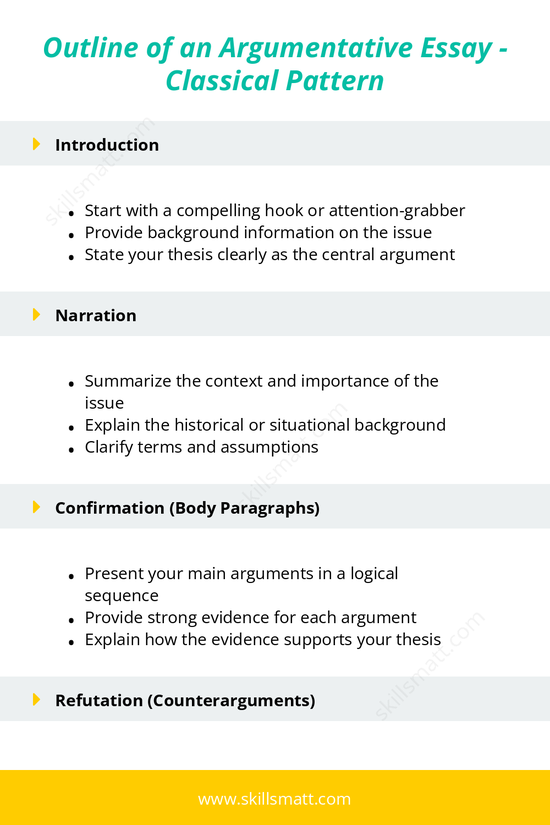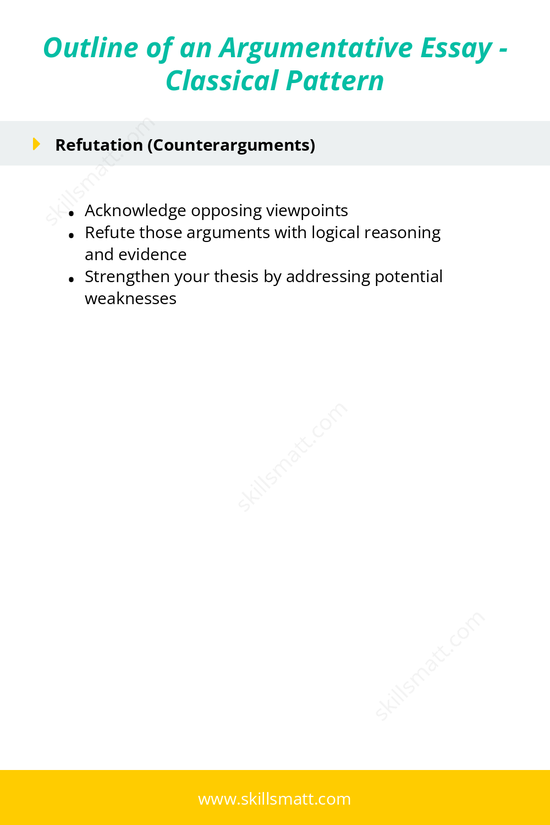Outline of an Argumentative Essay - Classical Pattern
Writing an argumentative essay following the classical pattern is an effective way to construct a solid argument and persuade your readers. This method is organized and methodical, allowing the writer to present a well-rounded and logical case. Below is an outline of the classical argumentative essay structure, along with detailed tips to guide you through the writing process.
Introduction
The introduction is the first impression your reader will have of your essay, so it's crucial to make it compelling. The goal is to set the stage for the arguments you will present and to clearly state your position.
- Start with a compelling hook: To capture the reader’s attention, begin with a hook. This could be a thought-provoking question, a surprising statistic, or a relevant anecdote that draws the reader in.
- Provide background information: After the hook, give some context on the issue at hand. This helps the reader understand the importance of the argument you're presenting and sets the stage for your thesis.
- State your thesis: End the introduction with a clear and concise thesis statement that sums up your central argument. Your thesis should outline the position you’re taking and what the reader can expect from the rest of the essay.
Narration
The narration section provides a foundation for your argument by explaining the context and importance of the issue. This section is important because it helps to create a shared understanding of the issue, ensuring that your audience can follow the arguments you present in the body paragraphs.
- Summarize the context: Discuss the background of the issue at hand. Why is it important to debate this topic? What implications does it have for society, politics, or individual lives?
- Explain the historical or situational background: Provide any historical information or situational context that is necessary for understanding the issue. This helps the reader gain perspective on how the situation developed.
- Clarify terms and assumptions: Ensure that the terms and assumptions used in the essay are clearly defined. This helps avoid misunderstandings later on in the essay and makes the argument more transparent.
Confirmation (Body Paragraphs)
The confirmation section is the core of the essay. Here, you present the strongest arguments that support your thesis. This section typically consists of multiple body paragraphs, each focusing on one key argument.
- Present your main arguments: Organize your arguments logically. Each paragraph should present one reason that supports your thesis statement. Make sure the arguments flow coherently from one to the next.
- Provide strong evidence: For each argument, provide evidence in the form of statistics, facts, expert opinions, or real-life examples. The more credible and relevant the evidence, the stronger your argument will be.
- Explain how the evidence supports your thesis: After presenting the evidence, explain how it reinforces your thesis. This step ensures that the reader understands the relevance of the evidence and how it contributes to the overall argument.
Refutation (Counterarguments)
A strong argumentative essay acknowledges and addresses opposing viewpoints. This section is important because it shows that you’ve considered the other side of the issue and can refute it effectively.
- Acknowledge opposing viewpoints: Present the main arguments of those who disagree with your thesis. This demonstrates that you’ve done your research and understand the broader debate.
- Refute the counterarguments: Use logical reasoning and evidence to counter the opposing viewpoints. This is your opportunity to show why your argument is stronger and more valid.
- Strengthen your thesis: By refuting counterarguments, you reinforce your position. It demonstrates that your thesis can withstand criticism and is supported by strong reasoning and evidence.
Conclusion
The conclusion is your final chance to leave a lasting impression on your reader. A strong conclusion not only restates the thesis but also ties together the main points of your argument.
- Restate your thesis: Begin your conclusion by restating your thesis in light of the arguments you've presented. However, don’t just repeat it verbatim. Instead, paraphrase your thesis to show that it has been reinforced throughout the essay.
- Summarize your key points: Briefly summarize the main points of evidence you’ve discussed in the body paragraphs. This recap reinforces the strength of your argument.
- End with a powerful statement: Conclude with a strong closing thought that leaves the reader thinking. This could be a call to action, a prediction, or a thought-provoking quote that highlights the significance of your argument.
By following this classical argumentative essay outline, you can present a well-structured, compelling argument. Each section is designed to guide your reader through the logical steps of your reasoning, from understanding the issue to considering the evidence and ultimately embracing your point of view. With careful attention to each part of the essay, you can craft an argumentative essay that is persuasive and effective in making your case.


